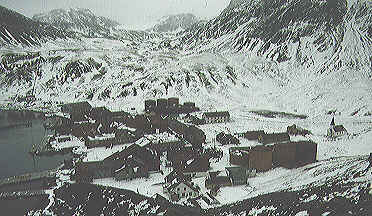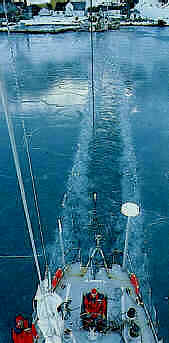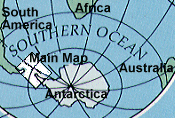|
" Shackleton's grave is impressive in its
simplicity and borrows dignity from the grandeur of its
surroundings. By its side I first read the service, which was
printed both in English and Norwegian, the stone being draped with
a large Union Jack. At the end of the service I pulled the
retaining cord, and thus releasing the Union Jack, disclosed the
rugged and beautiful stone of grey granite inscribed merely with
the name and dates of birth and death of the great spirit whose
mortal remains had been laid to rest beneath it..."
So wrote the governor of the Falkland Islands and Dependencies,
Arnold Hudson on 24 February 1928, just after he had celebrated
one of the few funerals to take place on South Georgia.
Shackleton died of a heart attack while on his way to Antarctica
for his fourth expedition in his ship QUEST. He was 47 years old.
His body was already on its way back to England, but his wife had
it diverted back to Grytviken, to be buried in the land he loved.
He now lies in a tiny, peaceful cemetery very close to the whaling
station with a few whalers, a British governor who died in an
accident and an Argentine soldier killed during the Falkland war.
The head of his grave is the only one that points to the south,
all the others face east. On the stone there is the nine pointed
star that belonged to the Shackleton family and on the reverse you
can read a quote from Robert Browning- Shackleton's favorite poet
- "I hold that a man should strive to the uttermost for his
life's set prize."
Shackleton's grave is amongst the historical monuments in
Grytviken that are the care of a British couple Tim and Pauline
Carr, who have been here for four years. They met us at the jetty
and invited all ten of the crew into the museum's anteroom for
breakfast: eggs, bacon, sausage, scones, marmalade galore!
Since 1968, the Carr's home (in which three would be a crowd)
has been a 28 foot engineless wooden cutter called the 'Curlew'.
She will celebrate her hundredth birthday in 1998 and is a
traditional Falmouth Quay Punt. The Curlew has taken the Carrs
from the Arctic circle to the Antarctic Peninsula. They first
arrived in South Georgia in November 1992.
In 1995, they chose to become the first family, since the end of
the whaling days, to live year round on the island. Since then
they have played an invaluable part in the establishment of the
South Georgia whaling museum. The Curlew is moored alongside the
rusting seal catcher 'Petrel'. She is always ready for sea and
many times has taken them around the island to observe the
wildlife and also to ski and climb, activities they have taken up
for the first time since coming to South Georgia.
The museum is housed in the building that was once the living
quarters of the management known as the 'Villa'. It is filled with
artifacts, books and documents that tell the history of the
whaling era and is kept in good order by the Carrs. They are also
coordinating 7 volunteer workers, who are renovating the church
which Captain Larsen had had built in Norway and reassembled here
on Christmas Eve of 1913.
We are not the only guests at the Carrs impromptu breakfast.
There is also a lively, dark skinned and blue eyed Frenchman. He
is Jerome Poncet, well known in the sailing world for his trip
around the world in 1969 on the boat 'Damien', but especially as
'the' expert in these remote Antarctic and sub Antarctic seas.
Jerome and his life companion Sally, a tall, blond girl from
Tasmania with whom in 1975 he built 'Damien II', have sailed the
southern oceans for twenty years. Damien II is a 51 ft schooner,
specially designed to withstand the rigours of the Polar seas and
was the prototype for Pelagic: steel hull, lifting keel and 86
horse power engine.
For a number of years, Jerome and Sally, who is a biologist,
together with their 3 sons, (the first of whom was born in Leith
Harbour on board the boat) lived on board Damien II while
monitoring seal and sea bird colonies. Since then Damien has been
chartered many times by the British Antarctic Survey and various
film and television crews, notably the BBC. We discover that
Jerome has a washing machine on Damien II: "we had 3 children
on board!" he tells me laughing while proudly lifting the
bunk under which it is located. He also explains how he used to
make the hot water on the stove for the wash cycle!
In appearance, Jerome looks like a tough pirate of another era,
clad in fishing boat quality, begreased jacket and trousers and
always sporting a hand rolled cigarette dangling from his lips.
Known as the 'guru' of southern sailing, he has accumulated a
storehouse of knowledge, some readily forthcoming, some not! He is
always animated and a born raconteur. The 'Curlew' and 'Damien
II'- together with Bill Tilman's 45 foot 'Mischief', were chosen
in 1995 for an issue of new stamps to mark the special connection
they had with the island of South Georgia. This first day cover of
16.11.95 is, of course, available for sale at the museum!
Elena Caputo

Grytviken
click
for full size image

|

![]()

![]()




